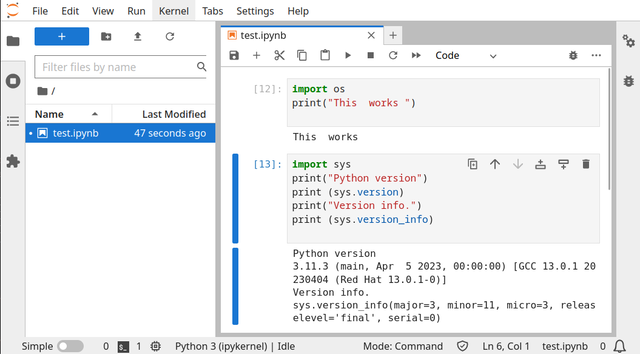JupyterLab is the latest web-based interactive development environment for notebooks, code, and data. Its flexible interface allows users to configure and arrange workflows in data science, scientific computing, computational journalism, and machine learning. A modular design invites extensions to expand and enrich functionality.
Let's test with these python modules: jupyterlab, notebook and voila.
First, I install with pip tool the jupyterlab python module:
pip install jupyterlab
Collecting jupyterlab
...
Successfully installed anyio-4.9.0 argon2-cffi-25.1.0 argon2-cffi-bindings-21.2.0 arrow-1.3.0 asttokens-3.0.0 async-lru-2.0.5
attrs-25.3.0 babel-2.17.0 bleach-6.2.0 cffi-1.17.1 comm-0.2.2 debugpy-1.8.14 defusedxml-0.7.1 executing-2.2.0
fastjsonschema-2.21.1 fqdn-1.5.1 h11-0.16.0 httpcore-1.0.9 httpx-0.28.1 ipykernel-6.29.5 ipython-9.4.0
ipython-pygments-lexers-1.1.1 isoduration-20.11.0 jedi-0.19.2 json5-0.12.0 jsonpointer-3.0.0 jsonschema-4.24.0
jsonschema-specifications-2025.4.1 jupyter-client-8.6.3 jupyter-core-5.8.1 jupyter-events-0.12.0 jupyter-lsp-2.2.5
jupyter-server-2.16.0 jupyter-server-terminals-0.5.3 jupyterlab-4.4.4 jupyterlab-pygments-0.3.0 jupyterlab-server-2.27.3
matplotlib-inline-0.1.7 mistune-3.1.3 nbclient-0.10.2 nbconvert-7.16.6 nbformat-5.10.4 nest-asyncio-1.6.0 notebook-shim-0.2.4
overrides-7.7.0 pandocfilters-1.5.1 parso-0.8.4 platformdirs-4.3.8 prometheus-client-0.22.1 prompt_toolkit-3.0.51
psutil-7.0.0 pure-eval-0.2.3 pycparser-2.22 python-json-logger-3.3.0 pywin32-310 pywinpty-2.0.15 pyyaml-6.0.2 pyzmq-27.0.0
referencing-0.36.2 rfc3339-validator-0.1.4 rfc3986-validator-0.1.1 rpds-py-0.26.0 send2trash-1.8.3 sniffio-1.3.1
stack_data-0.6.3 terminado-0.18.1 tinycss2-1.4.0 tornado-6.5.1 traitlets-5.14.3 types-python-dateutil-2.9.0.20250516
uri-template-1.3.0 wcwidth-0.2.13 webcolors-24.11.1 webencodings-0.5.1 websocket-client-1.8.0Next, the install of the notebook python module
pip install notebook
Collecting notebook
...
Installing collected packages: notebook
Successfully installed notebook-7.4.4This python package named voila will help us to use online graphic user interfaces:
pip install voila
Collecting voila
...
Successfully installed voila-0.5.8 websockets-15.0.1The voila package need to work with ipywidgets python package:
pip install ipywidgets
Collecting ipywidgets
...
Successfully installed ipywidgets-8.1.7 jupyterlab_widgets-3.0.15 widgetsnbextension-4.0.14Let's start the jupiter tool with this command:
jupyter notebookI used an default python example with a slider:
import ipywidgets as widgets
from IPython.display import display
slider = widgets.IntSlider(value=5, min=0, max=10)
display(slider)This command will start the web with the slider using the voila command:
voila test.ipynbThe result is this:

